Call Number : RR-092/CT
Syromalabar Sabhayude Qurbanakramam-1962
സീറോമലബാർ സഭയുടെ കുർബാനക്രമം -1962

Detail of 1 to 58 pages
- Printed at - The Mar Thoma Sleeha Press, Alwaye-1962
- Imprimatur
- Joseph Parecattil - (Archbishop of Ernakulam)
- Mathew Kavukatt - (Archbishop of Changanachery)
- George Alapat - (Bishop of Trichur)
- Thomas Tharayil - (Bishop of Kottayam)
- Sebastian Vayalil - (Bishop of Palai)
- Sebastian Vallopilly - (Bishop of Thellicherry)
- Mathew Pothanamuzhy - (Bishop of Kothamangalam)
- Date of Publication - 3rd July, 1962
Details of 1 to 62 pages
- Printed at - The Mar Thoma Sleeha Press Alwaye- 1960
- Censores (CONCORDAT CUM ORIGINALI )
- Fr. Joseph Vithayathil
- Fr. John Puthankary
- Date & Place of Publication - 12-05-1960, Ernakulam
- Imprimatur :- JOSEPH PARECATTIL (Archbishop of Ernakulam)
Details of 1 to 62 pages
- Printed at - The Mar Thoma Sleeha Press Alwaye- 1960
- Censores (CONCORDAT CUM ORIGINALI )
- Fr. Joseph Vithayathil
- Fr. John Puthankary
- Date & Place of Publication - 12-05-1960, Ernakulam
- Imprimatur :- JOSEPH PARECATTIL (Archbishop of Ernakulam)
This is a digital copy of the first edition (1962) of the vernacular thaksa (Missal) of the Syro Malabar Church. This edition will be a useful resource for researchers on the history of the liturgies in Kerala. The process of vernacularizing the East-Syriac liturgy into Malayalam started in the 1950s, much before the Second Vatican Council (1964). The Syro Malabar Church promulgated the vernacular version on 3 July 1962. Interestingly, the first edition was a bilingual (Malayalam and Syriac) one. The thaksa retained about 19 prayers from the Syriac Thaksa and printed them in Syriac script. These are mostly prayers that the priest recites in a low voice in private, and does not require the people to respond by Amen. One exception is the rite of dismissal that the deacon proclaims (p.17) before preparing gifts. The Institution Narrative appears only in Syriac (pp.32-32). The clergy at this period knew enough Syriac to celebrate Qurbana in Syriac. The congregation had a general sense of the content of these prayers. What is conspicuous by its absence is the hymn-version of such solemn prayers as the Trisagion and the Resurrection Hymn.
Even after the vernacularization, the solemn, sung celebration of Qurbana continued in Syriac for several years. Gradually, proficiency in the Syriac language became a non-requirement for the candidates to the priesthood and the celebration of Qurbana became entirely in Malayalam. Meanwhile, Fr. Abel Periyappuram, CMI and K. K. Antony Master created text and music for solemn celebration entirely in Malayalam.
In conclusion, In contrast to what happened in the Latin rite, the transition from Syriac to Malayalam was the result of a gradual process. The first edition of the thaksa is witness to that process. Hence the relevance of this document.
To get a complete copy, contact us at library @thecmsindia.org
Joseph J. Palackal, CMINew York
7 October 2020
Keywords - Syromalabar Sabhayude Qurbanakramam, The Mar Thoma Sleeha Press, Syro Malabar Church, St Thomas Christians, Joseph Parecattil , Mathew Kavukatt George Alapat, Thomas Tharayil, Sebastian Vayalil, Sebastian Vallopilly, Mathew Pothanamuzhy,Vernacular Thaksa, Vernacular Thaksa of Syro Malabar Church, East-Syriac liturgy, Syriac Thaksa, r. Joseph Vithayathil Fr. John Puthankary, Celebration of Qurbana, Qurbanakramam,
Courtesy - Fr. Cyril Thayyil



